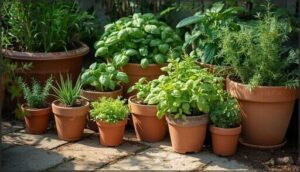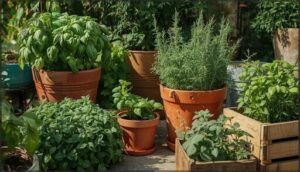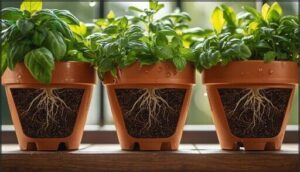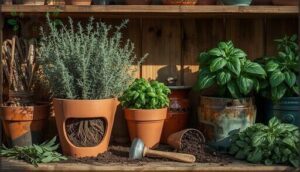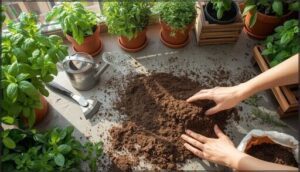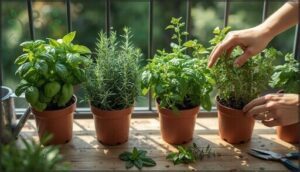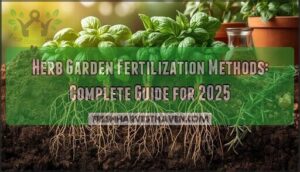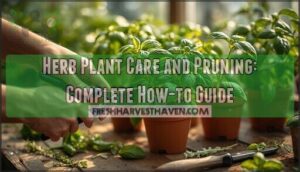This site is supported by our readers. We may earn a commission, at no cost to you, if you purchase through links.

Container gardening isn’t just economical; it’s remarkably forgiving, letting you control everything from soil quality to sunlight exposure in ways ground planting never could. Whether you’re working with a sunny balcony or a kitchen windowsill, you can cultivate a thriving herb garden that delivers flavor and fragrance all season long.
The key lies in matching the right herbs to appropriate containers and understanding their specific needs—knowledge that transforms even novice gardeners into confident growers.
Table Of Contents
- Key Takeaways
- Best Herb Varieties for Containers
- Choosing The Right Containers
- Preparing Potting Mix and Soil
- Essential Care for Container Herbs
- Troubleshooting and Maintenance Tips
- Frequently Asked Questions (FAQs)
- What are the best herbs to grow in pots?
- How deep should container be for herbs?
- What herbs grow best in pots?
- What herbs should not be potted together?
- How deep should a container be for herbs?
- What is the best container for growing herbs?
- Do herbs grow better in the ground or in pots?
- What herbs go well in pots together?
- Do herbs need full sun?
- Do herbs in pots need full sun?
- Conclusion
Key Takeaways
- Choosing the right herbs and matching them to suitable containers makes growing fresh basil, mint, rosemary, and others easy and affordable, even for beginners.
- Proper drainage, container depth, and high-quality potting mix are crucial for healthy roots and robust herb growth.
- Regular care—like watering when soil feels dry, feeding with organic fertilizers, and pruning—keeps your potted herbs productive and flavorful all season.
- Container gardening lets you control soil, sunlight, and pest management, turning even small spaces into thriving, low-maintenance herb gardens.
Best Herb Varieties for Containers
Not all herbs are created equal regarding container life. Some thrive in pots with minimal fuss, while others bring both flavor and beauty to your outdoor space.
Let’s explore the varieties that’ll set you up for success, whether you’re just starting out or looking to expand your container garden.
Easy-to-Grow Herbs for Beginners
If you’re new to container herb gardening, start with these winners that practically grow themselves:
- Basil: Matures in just 70 days with 6+ hours of daily sun, delivering 0.3 pounds of fragrant leaves monthly
- Mint: Thrives in moist soil, reaching 36 inches tall with minimal fuss
- Chives: Ready to harvest in 80 days, tolerates partial shade beautifully
- Oregano: Drought-tolerant and harvestable within 8 weeks
These easy herbs to grow forgive common growing mistakes while you master simple herb care techniques.
Many gardeners find container herb gardening offers easy access to fresh ingredients.
Herbs With Culinary and Ornamental Value
Once you’ve mastered the basics, why not choose herbs that look as good as they taste? These dual-purpose beauties bring both culinary uses of herbs and ornamental value to your containers.
| Herb | Aesthetic Appeal | Kitchen Use |
|---|---|---|
| Purple Basil | Striking burgundy foliage | Pesto, salads |
| Chives | Edible purple blooms | Garnish, dips |
| Tricolor Sage | Variegated leaves | Roasting, stuffing |
Edible flower choices like nasturtium add pops of color, while their aromatic scent enhances container garden design. To ensure healthy growth, remember that fertilization is necessary for herbs grown in containers.
Aesthetic herb pairing—say, lemon thyme with rosemary—creates foliage color impact that transforms ordinary pots into living centerpieces.
Invasive Herbs Suited for Pots
Some herbs can be garden bullies when planted in the ground, but they’re perfect candidates for container gardening. Mint containment is essential—this herb can increase root mass by 300% in one season, making pots your best defense.
Lemon balm doubles its size every six weeks, while oregano and bee balm thrive in 12–14″ containers. Even pennyroyal maintains a respectable lifespan when confined, unlike its rapid growth habit outdoors.
Flavor Profiles and Kitchen Uses
Beyond containment, your herb choices reveal distinct flavor profiles. Basil pairings shine in 60% of Mediterranean dishes—think pesto and tomato-based sauces. Parsley uses range from fresh salads to salt-free seasoning in 33% of health-conscious recipes.
Mint profiles deliver cooling sweetness to teas and desserts, while rosemary flavors add pine-like depth to roasted meats. These culinary herbs transform everyday cooking.
Choosing The Right Containers
Your container choice matters just as much as the herbs you grow. The right pot can mean the difference between a thriving plant and one that struggles to survive.
Let’s look at what you need to think about when selecting containers for your herb garden.
Container Size and Depth Requirements
Think of your container as an underground apartment—your herbs need enough room to stretch their roots comfortably.
Here’s what you need to know:
- Shallow-rooted herbs like thyme and chives thrive in 6–8 inch depths, perfect for compact spaces
- Medium feeders such as basil and cilantro prefer 8–10 inch containers for ideal depths
- Deep-rooted champions like rosemary demand 12+ inches to prevent root restriction
Remember, doubling pot depth can boost plant biomass by 43%. Larger volume impact means healthier growth—undersized containers reduce yields by 35%.
Material Options: Plastic, Clay, and More
When choosing herb containers, you’ll find each material brings unique trade-offs. Plastic pots offer considerable durability and moisture retention—18–25% more than terracotta—making them ideal for busy gardeners.
Clay containers provide breathability that prevents overwatering, though ceramic glazing reduces this benefit.
Metal options last longest but risk corrosion, while wood sustainability appeals to eco-conscious growers despite shorter lifespans.
Ensuring Proper Drainage for Healthy Roots
Without proper drainage, your container gardening dreams quickly turn into a waterlogged nightmare. A single 10 mm drainage hole cuts root rot incidence by 99%, while a 30–60 mm layer of gravel or sand reduces water retention by up to 11.4% in organic potting media.
A single 10 mm drainage hole can nearly eliminate root rot, turning waterlogged nightmares into thriving container gardens
Shallow containers need extra attention—they retain 20–30% more perched water than deeper pots, making well-drained soil and adequate drainage holes essential for root health.
Selecting Containers for Perennial Vs. Annual Herbs
Perennial herbs need more real estate than annuals—think root systems built for the long haul. You’ll want containers at least 12 inches deep for perennials like rosemary and sage, while annuals like basil thrive in 6–8 inch pots.
Container material matters for overwintering success too; terracotta breathes beautifully for Mediterranean perennials, but plastic works fine for short-lived annuals.
Your planting strategy shapes longevity impact.
Preparing Potting Mix and Soil
Getting your soil right is half the battle when growing herbs in containers. Unlike garden beds, where roots can search far and wide for nutrients, your potted herbs rely entirely on what you put in their containers.
Let’s break down how to create the perfect foundation for healthy, flavorful plants.
High-Quality Potting Mix Selection
Your potting mix acts as the engine that drives herb success—skip garden soil entirely. Premium mixes deliver results through these five essentials:
- Soil Composition: 40–60% peat moss or coir for moisture and aeration balance
- Drainage Materials: 30–40% perlite for well-drained soil conditions
- Organic vs. Synthetic: Organic blends boost essential oils by 18%
- Sustainable Factors: Peat-free options cut carbon impact 30%
- Commercial Benchmarks: Premium formulas increase herb biomass 20–25%
Soil Drainage and PH Needs for Herbs
Think of drainage as your first line of defense against root rot—poor soil drainage cuts herb vigor by up to 47%. You’ll want a fast-draining potting mix with perlite, boosting drainage capacity 40% over standard soil.
Most herbs thrive at pH 6.0–7.5, though basil and mint prefer 5.5–6.7. Test every six weeks to keep soil conditions ideal.
Adding Amendments for Nutrient Boost
Once your soil drains well, enriching it with organic amendments transforms container herb gardening outcomes. These organic matter additions improve soil conditions better than fertilizer alone.
Mix compost enrichment at a 1:3 ratio to boost nutrient retention by 40%, then add worm castings to increase nitrogen 25%. Biochar benefits include holding six times its weight in water—pair it with mineral supplementation for flavor-rich harvests.
Filling and Layering Containers Correctly
After boosting nutrients, container soil and drainage work together through strategic layering. Substrate stratification—placing fine-textured potting composition on top, coarse material below—can triple root growth compared to uniform mixes. Fill depth matters too; aim for 7 cm to optimize drainage efficacy while maintaining well-draining soil conditions.
Here’s your layering blueprint for containers:
- Add 60 mm coarse sand or gravel for a drainage layer
- Fill with stratified potting mix (fine over coarse)
- Leave 2 cm headspace below the rim
- Finish with surface mulching to reduce water loss
Essential Care for Container Herbs
Getting your herbs planted is just the beginning—the real magic happens when you dial in their daily care routine. Container herbs need the right balance of sun, water, nutrients, and regular attention to reach their full potential.
Let’s walk through the essentials that’ll keep your potted herbs thriving from spring through harvest season.
Sunlight Needs: Full Sun Vs. Partial Shade
Light intensity is everything for thriving herbs. Full sun herbs like basil, rosemary, and thyme need six to eight hours of direct sunlight exposure daily—south-facing patio orientation works beautifully. Partial shade lovers such as parsley and mint prefer three to four hours, reducing leaf burn risk.
Strategic herb placement and shading strategies help you match sunlight requirements to each plant’s needs perfectly.
Watering Techniques and Schedules
After dialing in proper sun exposure, watering becomes your next big win. Check moisture by poking your finger an inch deep—when the top layer feels dry, it’s time to water.
During hot spells, you’ll need to hydrate every day or two, while cooler weeks might stretch to twice weekly. Deep watering until drainage appears beats frequent shallow sips every time.
Fertilizing for Growth and Flavor
Your herbs need regular feeding because containers flush out nutrients faster than garden beds. Organic fertilizers like liquid seaweed and worm tea deliver essential organic matter every 7–10 days without overpowering delicate flavors.
You’ll spot nutrient deficiencies through yellowing leaves—a sign your fertilizer types might need adjusting. Balanced formulas around 6-3.5-7 NPK support flavor enhancement better than synthetic performance boosters, which can dilute those aromatic oils you’re growing for.
Pruning and Regular Harvesting Practices
When you harvest herbs regularly, you’re not just gathering leaves—you’re coaching plants to branch out and grow bushier. Sharp, sanitized tools make clean cuts that heal fast and prevent disease spread, while weekly trimming of new growth keeps your herbs productive and flavorful.
- Morning harvests after dew dries lock in essential oils at peak concentration
- Pinch stem tips above leaf nodes to trigger lateral branching and fuller canopies
- Never remove more than one-third of perennial herbs to guarantee vigorous regrowth
Troubleshooting and Maintenance Tips
Even with the best setup, container herbs can hit a few snags—yellowing leaves, unwanted visitors, or droopy stems that need a little TLC. The good news is that most problems have straightforward fixes, and with a few smart strategies, you can keep your plants thriving year-round.
Let’s walk through the most common challenges and how to tackle them head-on.
Pest and Disease Management in Containers
Pests and diseases can sneak up fast in containers, but you’re not defenseless. Start with pest identification—aphids, whiteflies, and fungal spots need different approaches.
Biological controls like predatory mites protect plant health without harsh chemicals, while proper spacing improves herb growing conditions and prevents disease.
If chemical applications become necessary, rotate products and respect residue concerns. Regular plant maintenance, including inviting beneficial insects, keeps your herb pest and disease control strategy balanced and your harvest safe.
Overwintering Herbs in Pots
When temperatures drop, your potted herbs face a tough test—winter survival depends on smart protective measures and moisture management. Here’s how to keep your green friends thriving through the cold:
- Raise terracotta pots off the ground to prevent frost-induced cracking and reduce root rot by up to 30%
- Wrap containers with fleece or bubble wrap, keeping roots up to 5°F warmer during freezes
- Mulch with 3–6 inches of straw after a hard freeze to retain soil warmth
- Water only when soil feels dry—about every 2–4 weeks—to avoid deadly overwatering
- For indoor placement, choose south-facing windows providing at least 6 hours of daily sunlight
Before hard frost hits, practice pruning dormancy by cutting hardy perennials down to 4–6 inches. This removes diseased tissue and encourages spring regrowth in 85% of plants. Stop fertilizing by late August to prevent tender growth vulnerable to frost damage.
Whether you’re herb overwintering outdoors in a sheltered spot or bringing containers inside, remember that potted herbs are two hardiness zones less hardy than in-ground plantings. Group your pots together to create microclimates that reduce stress by up to 35%, and you’ll extend your harvest while protecting your investment in growing herbs in containers.
Reviving Struggling Container Herbs
When your herb looks half-dead, don’t panic—most container failures stem from watering issues and can be fixed. Check soil drainage for herbs first; overwatering causes 70% of herb plant care problems.
Adjust light exposure to 6–8 hours daily, which revives 80% of struggling plants. Trim damaged leaves using proper pruning methods, apply balanced fertilizer monthly for nutrient correction, and inspect for pest remediation needs.
Root damage often rebounds with these fixes.
Maximizing Yields in Small Spaces
Think you can’t boost yields just because you’re short on space? Vertical gardening and smart container size choices change everything.
Apply soil amendments like enriched compost for 43% better growth, use succession harvest strategies for multiple crops yearly, and add smart gardening sensors to track moisture.
These container herb gardening tips let you multiply harvests in limited space when growing herbs in containers—even on tiny balconies.
Frequently Asked Questions (FAQs)
What are the best herbs to grow in pots?
You’ll find success with basil, mint, rosemary, and parsley—four beginner herb choices that thrive in pots without fuss.
These low-maintenance potted herbs deliver high yields and aromatic flavor, making container herb gardening rewarding from day one.
How deep should container be for herbs?
Aim for containers with at least 6 inches potting depth for most herbs, but deep-rooted varieties like parsley and rosemary thrive with 12 inches.
Greater container volume boosts biomass yield, supporting strong root systems and healthy soil drainage for herbs.
What herbs grow best in pots?
You’ll get great results with basil, mint, rosemary, thyme, chives, oregano, and parsley. These herb varieties thrive in pots, making container herb selection easy for beginners.
Just remember: potting mix matters, and sunlight requirements can vary.
What herbs should not be potted together?
As the saying goes, “oil and water don’t mix”—neither should sage and mint, dill and tomatoes, or fennel and cilantro. These mismatches cause allelopathic herbs, resource competition, growth inhibition, pest attraction, or pH incompatibility among companion herbs.
How deep should a container be for herbs?
Container depth matters—a good rule of thumb is six inches for most herbs, but some, like rosemary or parsley, need twelve inches for proper root depth and soil volume.
Always prioritize solid drainage and stable container material.
What is the best container for growing herbs?
Ever wondered why some herbs thrive while others struggle? Container Size Matters—choose pots at least 10–12 inches deep for Perennial Herb Pots, prioritize good Drainage Hole Size, and consider Self-Watering Benefits.
Container Material Impact—ceramic containers excel for container herb gardening.
Do herbs grow better in the ground or in pots?
Ground vs. Pots? It depends—herbs thrive in the ground with more root space, but pots win for Soil Nutrient Control, Pest Disease Control, and Environmental Adaptability.
Growing herbs in containers lets you tailor herb soil and sunlight requirements, plus watering herbs is simpler.
What herbs go well in pots together?
Picture a well-rehearsed jazz band—herbs like thyme, rosemary, sage, and oregano thrive together thanks to similar watering needs, sunlight compatibility, and soil pH.
Companion planting these creates a harmonious, low-maintenance container garden design bursting with flavor.
Do herbs need full sun?
Most herbs thrive with full sun—meaning at least six hours of direct sunlight daily. Sunlight intensity directly affects flavor impact and best growth, though shade-tolerant varieties and supplemental lighting can help if sunlight exposure falls short of herb sunlight requirements.
Do herbs in pots need full sun?
Most herbs crave full sun—at least six hours daily—to increase light and biomass, essential oil quality, and healthy photosynthetic rates.
Skimping on sunlight leaves herbs spindly, less flavorful, and vulnerable to pests and diseases.
Conclusion
Like a chef seasoning a favorite dish, growing herbs in containers lets you tailor every detail to your taste and space. Each pot becomes a miniature garden, offering fresh flavors and fragrant rewards just steps away.
With the right choices and care, those store-bought bundles become a distant memory. Your herbs will thrive, your kitchen will sing, and your confidence as a gardener will blossom—proof that a small container can hold an entire world of possibility.
- https://savvygardening.com/best-herbs-for-container-gardening/
- https://www.bellairfarm.com/blog/2023/4/4/update-culinary-herbs
- https://pmc.ncbi.nlm.nih.gov/articles/PMC3116467/
- https://digitalcollections.lipscomb.edu/cgi/viewcontent.cgi?article=1001&context=nut_ump
- https://www.doctoryum.org/en/stories/container-herb-garden-with-kids

